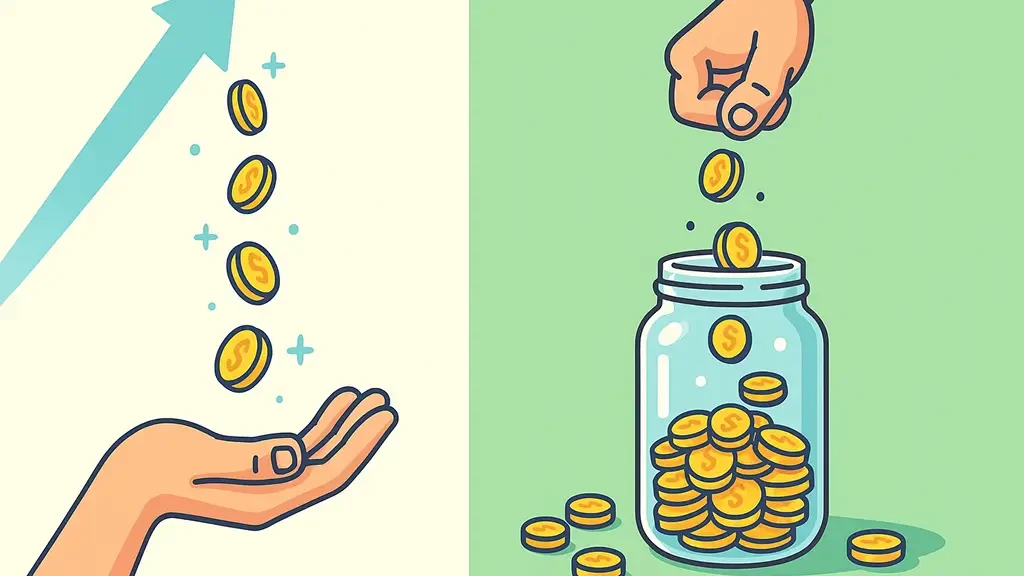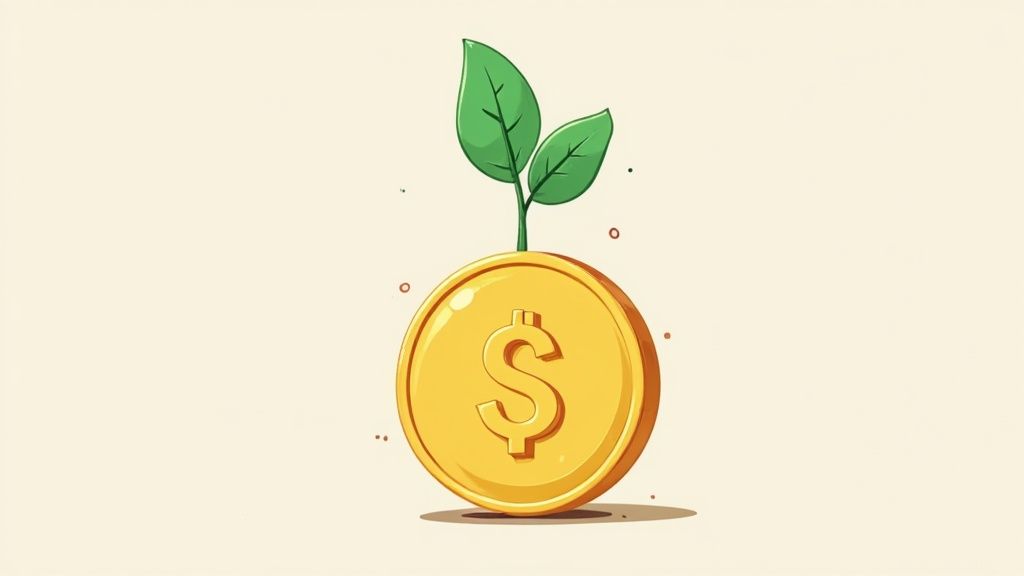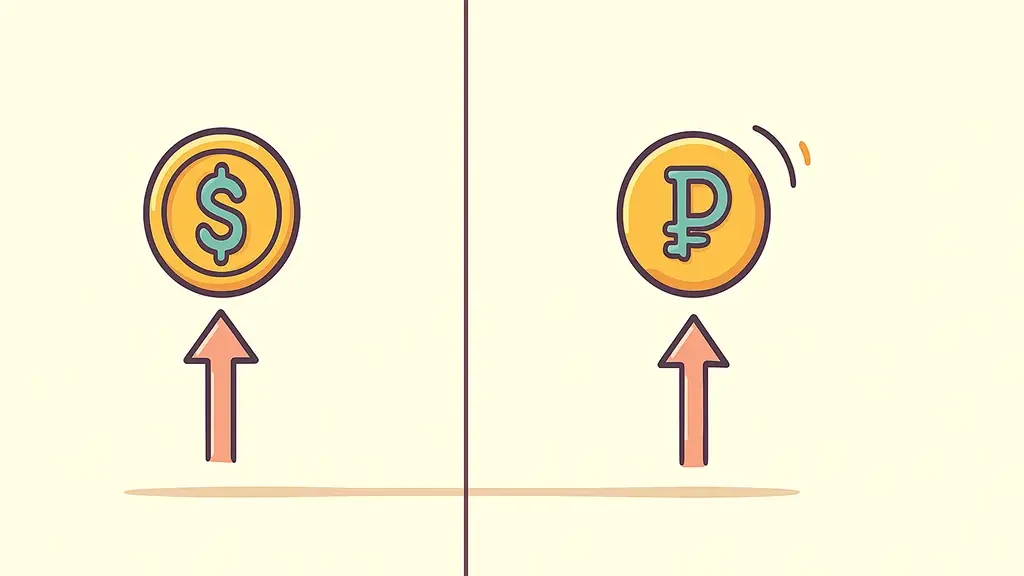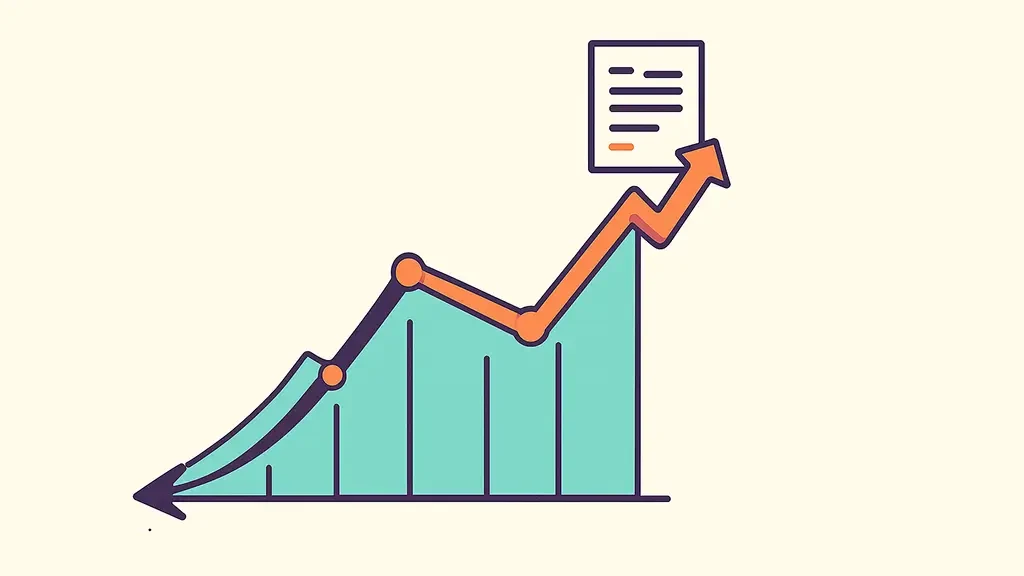Dividend vs Return of Capital A Complete Guide
Understand the dividend vs return of capital debate. This guide breaks down tax implications, portfolio impact, and key differences for investors.

The real difference between a dividend vs return of capital is refreshingly simple. A dividend is a slice of a company's profits sent your way, which is a return on your investment. A return of capital (ROC), however, is just your own money coming back to you—a return of your investment.
Getting this distinction right is non-negotiable. It has a direct impact on your taxes, the cost basis of your investment, and even tells you a story about the company's financial health.
Decoding Your Investment Distributions

When cash from a company you've invested in hits your account, it's tempting to think of it all as profit. But where that money comes from is what truly matters, and it has major consequences for your portfolio. Nailing this down is a fundamental step for any serious investor.
When you can tell these payments apart, you get a much clearer picture of how your portfolio is actually performing and whether the companies you own are on solid ground.
This guide will break it all down. We'll walk through:
- The Source of Funds: Where does the cash originate? Is it from company earnings or its capital reserves?
- Tax Implications: How does the IRS treat each payment, and what does that mean for your tax bill come April?
- Portfolio Impact: How does each distribution affect your investment's cost basis and your true total return?
- Company Signals: What is a company telling you about its business when it sends you one type of payment versus the other?
This isn't just theory; it's the bedrock of a smart investment strategy. Knowing this stuff helps you properly evaluate investment opportunities and make decisions with confidence. When you can spot the difference between these two payments, you can finally see your real returns.
How Dividends Signal Company Health

A dividend payment is more than just cash in your pocket; it’s a direct signal of a company’s financial strength and stability. Unlike other distributions, dividends are paid out from a company's accumulated profits, also known as retained earnings. This tells you the business isn't just getting by—it's thriving enough to share the wealth with its owners.
When a board of directors declares a dividend, they’re making a public statement of confidence. It says the company has enough cash to cover operations, fund future growth, and still have plenty left over to reward shareholders. This is a massive differentiator in the dividend vs return of capital discussion, since a return of capital doesn't necessarily come from profits at all.
The Mechanics of Dividend Payments
The dividend payment process follows a strict, predictable timeline. Understanding these key dates is essential for any income investor.
- Declaration Date: This is the day the board of directors officially announces its plan to pay a dividend.
- Record Date: You must be a registered shareholder on this date to be eligible for the payment.
- Ex-Dividend Date: Typically set one business day before the record date. If you buy the stock on or after this date, the seller gets the dividend, not you.
- Payment Date: The day the company actually sends the cash to its shareholders.
This clear-cut process provides the kind of predictability that income-focused investors rely on. It reinforces the idea that dividends are a structured, deliberate reward from a well-managed organization.
Understanding Dividend Types
Not all dividends are created equal, especially when Uncle Sam gets involved. While most dividends are paid in cash, the most critical distinction is how they're taxed.
Key Insight: The difference between a qualified and non-qualified dividend hits your wallet directly. Qualified dividends get taxed at the lower long-term capital gains rates, while non-qualified dividends are taxed at your much higher ordinary income tax rate.
This tax treatment highlights why the dividend's source and your holding period matter so much. Over the long run, these payments have been a huge part of total stock market returns. From 1926 to early 2025, dividends have accounted for roughly 31% of the total return of the S&P 500 Index, proving their staying power.
To really get under the hood and understand what a company's distributions are telling you, a deeper financial analysis is invaluable. Expert services like outsourced financial analysis can help decode these signals with far greater precision. At the end of the day, a consistent dividend is a tangible reward for investing in a successful, profit-generating company.
Decoding a Return of Capital Distribution

While a dividend feels like a reward paid from profits, a return of capital (ROC) is something else entirely. It's not a slice of the company's earnings. Instead, the company is simply giving you back a piece of your original investment.
Think of it like getting a partial rebate after you've already bought something. The cash you get isn't new money you've earned; it’s a refund of money you already spent. This is the absolute core of the dividend vs return of capital debate, and it has massive tax and accounting implications for your portfolio.
Where Does ROC Come From?
Unlike a dividend, which has to be paid from a company's retained earnings, a return of capital can come from a few different places. A company might fund an ROC distribution by dipping into:
- Cash Reserves: Using extra cash sitting on the balance sheet that isn't earmarked for operations or new projects.
- Asset Sales: Handing out the proceeds after selling off a building, a subsidiary, or another big-ticket asset.
- Borrowed Funds: In some situations, a company might even take on debt to fund shareholder distributions.
Because these funds aren't tied to day-to-day profitability, an ROC payment tells you nothing about how well the business is actually doing right now. It’s just a capital shift from the company's books back to the owners. And that mechanical difference changes everything about how it hits your investment records.
The Impact on Your Cost Basis
Here's the most critical part: receiving a return of capital directly impacts your cost basis—the original price you paid for your shares. Every dollar you receive as an ROC distribution reduces your cost basis by that exact amount. This isn't optional; it's a mandatory accounting adjustment you have to make.
Key Takeaway: A return of capital distribution is tax-deferred, not tax-free. It chips away at your cost basis, which ultimately increases the taxable capital gain you'll face when you eventually sell the stock.
Let's walk through a quick example. Say you buy 100 shares of a stock at $20 per share, putting your total cost basis at $2,000. The company then announces a $1 per share return of capital distribution.
- You get $100 in cash ($1/share x 100 shares).
- Your cost basis is now reduced by that $100.
- Your new adjusted cost basis becomes $1,900, or $19 per share.
Now, when you go to sell those shares down the road, your capital gain will be calculated from that lower $19 starting point, not your original $20. This is precisely why ROC is called a "tax-deferred" distribution. You don't pay tax on the $100 when you receive it, but you're setting yourself up for a bigger tax bill later. That delayed tax hit is a crucial strategic point when weighing a dividend vs return of capital.
Comparing Tax and Portfolio Impact

This is where the rubber meets the road. The real difference between a dividend and a return of capital pops up when you look at how they hit your wallet—both through taxes and the long-term value of your portfolio. These aren't just minor accounting details; they're at the core of your investment strategy and directly shape your actual take-home returns.
When you receive a dividend, it's considered income, and you owe taxes on it in the year you get it. The rate depends on the type of dividend and how long you’ve held the stock, falling into either your standard income tax bracket or the more favorable qualified dividend rate.
A return of capital (ROC) works completely differently. It's initially a non-taxable event. Instead of being taxed as income, the distribution simply lowers your investment's cost basis, kicking the tax can down the road until you eventually sell.
Immediate Tax Liability
The most obvious contrast is what happens come tax season. A dividend payment from a profitable company creates a tax bill right now. That's a huge deal for anyone trying to manage their annual income, and it's essential to understand those liabilities. In some places, the rules get even more complex, like with Australian dividend deductions and franking credits, where the tax treatment can dramatically alter your net benefit.
On the flip side, ROC offers a fantastic tax-deferral advantage. By reducing your cost basis instead of generating income, it pushes that tax obligation into the future. This lets your money stay invested and work for you longer.
Key Insight: A dividend triggers an immediate tax bill, chipping away at your returns in the current year. A return of capital postpones the tax, preserving your capital now but setting you up for a larger capital gains bill later.
This is exactly why some investments, like many REITs and Master Limited Partnerships (MLPs), are structured to distribute cash as ROC. It's a massive draw for tax-conscious investors. In fact, in 2023, roughly 9% of all dividends from REIT common shares were classified as a return of capital.
Long-Term Portfolio Accounting
Over the long haul, the accounting effects are just as significant. Because a dividend is just a slice of the company's profits, it has zero impact on your original cost basis. If you bought a share for $50, your basis stays $50, no matter how many dividend checks you cash.
An ROC distribution, however, directly changes your investment's financial DNA. The mechanic is simple but potent: for every dollar of ROC you get, your cost basis for that share drops by a dollar. This isn't optional—it's a mandatory adjustment that directly impacts how much capital gain or loss you'll report when you sell. Knowing how to diversify an investment portfolio properly means grasping these kinds of nuanced impacts on each asset you own.
To give you a clearer picture, let's break down the core differences side-by-side.
Dividend vs Return of Capital Key Differences
This table offers a snapshot of how these two types of distributions stack up against each other on key attributes.
Ultimately, while both put cash in your pocket, they tell very different stories about where that money came from and how it affects your financial position.
While dividends have long been a key part of total returns, it's crucial to see the bigger picture. Modern analysis often shows that just chasing a high dividend yield can be misleading. Factors like overall profitability and a company's total shareholder yield—which includes dividends, buybacks, and return of capital—give a much more complete view of how a company creates value for its investors.
Choosing Between Distribution Types
Turning financial theory into a real-world investment strategy is what sets successful investors apart. Deciding whether a dividend or a return of capital (ROC) fits your portfolio isn't some abstract exercise—it's a concrete choice driven by your financial goals, tax bracket, and how much risk you’re comfortable with. There's no single "best" answer in the dividend vs return of capital debate, only what's right for you.
An investor on the cusp of retirement, for example, will likely rely on their portfolio for steady, predictable income. They’ll naturally gravitate toward companies with a long track record of paying stable dividends. For them, it’s all about immediate cash flow from profitable businesses.
Contrast that with a younger investor in a high tax bracket. The tax-deferral perks of a return of capital can look incredibly appealing. For them, an ROC isn't just a payout; it's a strategic tool for compounding wealth. It allows more of their money to stay invested and grow, pushing the tax bill far into the future.
Evaluating Your Investment Goals
The right choice boils down to what you want your money to do. Are you building a portfolio for immediate income, or is your focus on long-term, tax-efficient growth?
For Income Seekers: A consistent dividend from a blue-chip company is hard to beat for reliability. You're getting a slice of actual profits, which signals the company's financial health and gives you cash for living expenses or reinvesting.
For Tax-Conscious Growers: A return of capital, particularly from structures like REITs or MLPs, can be a powerful way to defer taxes. By lowering your investment's cost basis, it pushes the tax liability down the road, a key principle for maximizing long-term gains.
The critical question isn't just what you're receiving, but why. A dividend is your reward for a company's success. An ROC can be either a strategic tax advantage or a warning sign that the company can't cover its payout from profits alone.
Knowing how to fit these different distributions into a bigger picture is crucial. To get a better handle on how different asset types work together, it's worth learning what is modern portfolio theory and its core ideas on diversification.
Analyzing the Source of a Return of Capital
This is where you need to roll up your sleeves and do some digging. Not all ROC distributions are created equal, and you have to understand the context to know what that payment really means.
Strategic ROC (Often a Green Flag):
In certain types of investments, an ROC is a feature, not a bug. It's part of the design.
- Real Estate Investment Trusts (REITs): These often use non-cash deductions like property depreciation to shelter income, which results in distributions being classified as ROC. In 2023, about 9% of all REIT common share dividends were classified as a return of capital.
- Master Limited Partnerships (MLPs): Typically found in the energy sector, these are structured to pass income and tax benefits directly to investors, making ROC a core component.
Warning Sign ROC (Often a Red Flag):
When a standard company that should be turning a profit starts paying an ROC, it’s time to ask some hard questions.
- Is it a one-time thing? The company might just be distributing cash from a major asset sale. That's usually fine.
- Is it happening again and again? If a company consistently funds its "dividend" with ROC, it could be a sign that its fundamentals are eroding. It suggests they don't have the earnings to support the payout.
Ultimately, your ability to tell the difference between a smart financial tool and a sign of corporate trouble is what will empower you to make the right call.
Frequently Asked Questions
When you're digging into the differences between dividends and returns of capital, a few common questions always seem to pop up. Let's tackle them head-on to clear up any lingering confusion.
Is a Return of Capital Always a Bad Sign?
Not at all, but the context is absolutely critical. Think of it this way: for a typical company, a return of capital (ROC) can be a red flag, suggesting it doesn't have the profits to cover its shareholder payout. But for other types of investments, it’s a totally normal—and even desirable—feature.
Many investors specifically hunt for investments that generate ROC because of its tax advantages. The real question is why you're receiving it.
- Strategic ROC: This is common in specific structures like Master Limited Partnerships (MLPs) and Real Estate Investment Trusts (REITs). They are designed from the ground up to pass through income and tax benefits, making ROC a planned part of their distribution strategy. In 2023, for instance, about 9% of distributions from REIT common shares were classified as a return of capital.
- Warning Sign ROC: Now, if a regular company that usually pays dividends from its earnings suddenly starts paying out ROC, it's time to put on your investigator hat. This often means its core business is struggling to generate enough cash to keep its promises to shareholders.
How Do I Know If a Payment Is a Dividend or ROC?
You don’t have to play detective here. Your brokerage is required to lay it all out for you. Every year, you'll get an IRS Form 1099-DIV that breaks down every distribution you received from your investments.
This form is your official guide for tax season. It neatly separates the different types of payments you've received, leaving no room for guesswork.
Your Tax Roadmap: On Form 1099-DIV, Box 1a shows your total ordinary dividends. Look over to Box 3, and you'll find "Nondividend distributions"—that's the IRS's official term for a return of capital.
This document is your source of truth. It gives you the exact dollar amounts for each category, making it simple to tell a dividend from a return of capital when you're preparing your taxes.
Can a Single Payment Be Both a Dividend and a Return of Capital?
Yes, and honestly, this happens all the time. A company’s total distribution to its shareholders is often a cocktail, mixed from different funding sources.
Imagine a company plans to pay out $1.00 per share. It might have enough profit to cover 75 cents of that, which would be a true dividend. To make up the difference, it might pull the remaining 25 cents from its cash reserves, making that portion a return of capital.
Your Form 1099-DIV will show this split with perfect clarity. It will tell you exactly how much of your total payment is a taxable dividend and how much is a non-taxable ROC that lowers your cost basis. This kind of detail is essential for accurate portfolio tracking and tax reporting, really driving home the practical differences in the dividend vs. return of capital dynamic.
Ready to gain a clear, unified view of your entire investment portfolio, including dividends and total returns? PinkLion provides advanced analytics, automatic broker connections, and dividend forecasting to help you make smarter decisions. Stop guessing and start seeing the complete picture of your financial health. Get started for free on pinklion.xyz and take control of your investments today.
